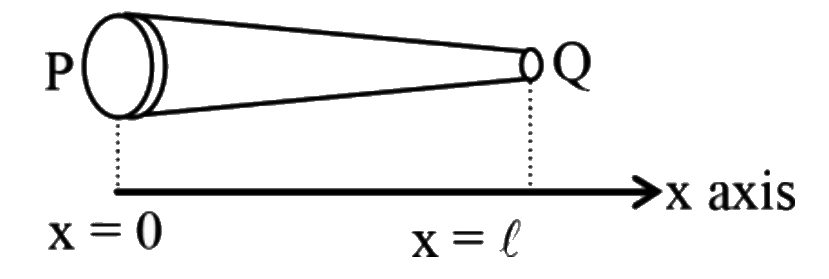Two different wires X and Y of same diameter but different materials are joined in series across a battery. If the number density of electrons in X is twice that in Y, find the ratio of drift velocity of electrons in the two wires .
To solve the problem, we need to find the ratio of the drift velocities of electrons in two wires X and Y, given that the number density of electrons in wire X is twice that in wire Y.
1. Understanding the Given Information:
- Let nx be the number density of electrons in wire X.
- Let ny be the number density of electrons in wire Y.
- According to the problem, nx=2ny.
2. Current in Series:
- Since the wires are connected in series, the current through both wires is the same. Therefore, we can state:
Ix=Iy
3. Expression for Current:
- The current I in a wire can be expressed as:
I=n⋅e⋅A⋅vd
where:
- n = number density of electrons,
- e = charge of an electron,
- A = cross-sectional area of the wire,
- vd = drift velocity of electrons.
4. Setting Up the Equations:
- For wire X:
Ix=nx⋅e⋅A⋅vx
- For wire Y:
Iy=ny⋅e⋅A⋅vy
5. Equating the Currents:
- Since Ix=Iy, we can equate the two expressions:
nx⋅e⋅A⋅vx=ny⋅e⋅A⋅vy
6. Canceling Common Terms:
- We can cancel e and A from both sides (since they are the same for both wires):
nx⋅vx=ny⋅vy
7. Finding the Ratio of Drift Velocities:
- Rearranging the equation gives:
vxvy=nynx
- Substituting nx=2ny:
vxvy=ny2ny=12
8. Final Result:
- Therefore, the ratio of the drift velocities of electrons in wires X and Y is:
vxvy=12
Summary:
The ratio of the drift velocity of electrons in wire X to that in wire Y is 12.
- Let nx be the number density of electrons in wire X.
- Let ny be the number density of electrons in wire Y.
- According to the problem, nx=2ny.
- Since the wires are connected in series, the current through both wires is the same. Therefore, we can state:
Ix=Iy
- The current I in a wire can be expressed as:
I=n⋅e⋅A⋅vd
where:
- n = number density of electrons,
- e = charge of an electron,
- A = cross-sectional area of the wire,
- vd = drift velocity of electrons.
- For wire X:
Ix=nx⋅e⋅A⋅vx
- For wire Y:
Iy=ny⋅e⋅A⋅vy
- Since Ix=Iy, we can equate the two expressions:
nx⋅e⋅A⋅vx=ny⋅e⋅A⋅vy
- We can cancel e and A from both sides (since they are the same for both wires):
nx⋅vx=ny⋅vy
- Rearranging the equation gives:
vxvy=nynx
- Substituting nx=2ny:
vxvy=ny2ny=12
- Therefore, the ratio of the drift velocities of electrons in wires X and Y is:
vxvy=12
The ratio of the drift velocity of electrons in wire X to that in wire Y is 12.
Topper's Solved these Questions
- XII BOARDSBook:XII BOARD PREVIOUS YEAR PAPER ENGLISHChapter:XII BOARDSExercise:SET -II
Explore 9 Videos
- XII BOARDSBook:XII BOARD PREVIOUS YEAR PAPER ENGLISHChapter:XII BOARDSExercise:SET -III
Explore 4 Videos
- XII BOARDSBook:XII BOARD PREVIOUS YEAR PAPER ENGLISHChapter:XII BOARDSExercise:SET-III DELHI BOARD
Explore 10 Videos
- SAMPLE PAPER 2019Book:XII BOARD PREVIOUS YEAR PAPER ENGLISHChapter:SAMPLE PAPER 2019Exercise:SECTION D
Explore 6 Videos
Similar Questions
Two wires each of radius of cross section r but of different materials are connected together end to end (in series). If the densities of charge carries in the two wires are in the ratio 1:4, the drift velocity of electrons in the two wires will be in the ratio:
View SolutionTwo wires each of radius of cross section r but of different materials are connected together end to end (in series). If the densities of charge carries in the two wires are in the ratio 1:4, the drift velocity of electrons in the two wires will be in the ratio:
View Solution
Knowledge Check
Two planets A and B have the same material density. If the radius of A is twice that of B, then the ratio of the escape velocity VA/VB is
A2B√2C1/√2D1/2
Two wires of the same material but of different diameters carry the same current i. If the ratio of their diameters is 2:1 , then the corresponding ratio of their mean drift velocities will be
View SolutionTwo metallic wires of the same material B, have the same length out cross-sectional area is in the ratio 1:2. They are connected (i) in series and (ii) in parallel. Compare the drift velocities of electrons in the two wires in both the cases (i) and (ii) .
View SolutionA constant potential difference is applied across a metal wire. Let the average thermal velocity of electrons in the wire be vt and let the drift velocity be vd . As the temperature of the wire rises:
View SolutionThere is a current of 40 ampere in a wire of 10−6m2 are of cross-section. If the number of free electron per m3 is 1029 then the drift velocity will be
View SolutionA wire of length l tapers uniformly from end P to end Q with the diameter at P twice that at Q. A potential difference is applied across the ends of the wire. Which graph represents the variation of the drift velocity V of the conduction electrons with distance x?

View SolutionAn aluminium wire of diameter 0.24 cm is connected in series to a copper wire of diameter 0.16 cm. The wires carry an electric current of 10 ampere. Find (i) current-density in the aluminium wire (ii) drift velocity of electrons in the copper wire. Given : Number of electrons per cubic metre volume of copper =8.4×1028.
View SolutionTwo wires A an dB of the same material, having radii in the ratio I : 2 and carry currents in the ratio 4: I. The ratio of drift speed of electrons in A and Bis :
View Solution